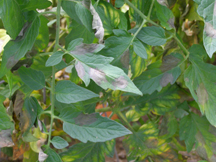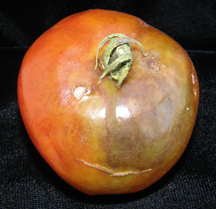Bulletin #2427, Tomato and Potato Late Blight Information for the Upcoming Growing Season: Recommended Practices Following a Season of Infestation
Steven B. Johnson, Extension Crops Specialist
For information about UMaine Extension programs and resources, visit extension.umaine.edu.
Find more of our publications and books at extension.umaine.edu/publications/.
Table of Contents:
- Late blight devastated crops in 2009
- What causes potato and tomato late blight?
- What conditions favor development of late blight?
- How do I recognize late blight?
- Does late blight affect plants other than potatoes and tomatoes?
- Will last year’s late blight affect this year’s garden?
- A new growing season is coming. What do I do about potato and tomato late blight?
- If late blight occurs
Late blight devastated crops in 2009

Many farmers and gardeners in Maine saw late blight on their potatoes and tomatoes for the first time in 2009 and experienced firsthand the amount and speed of crop destruction that it can cause. Introduction and widespread distribution of the late blight pathogen into Maine occurred during late June and July when potato and tomato plants were growing rapidly. Then extended periods of rainy and humid weather hit Maine, completing the disease triangle of pathogen, host, and environment. The results were devastating to the tomato and potato crops in many areas.
Few plant diseases in history can rival the widespread misery and despair that potato and tomato late blight can cause. Between 1845 and 1860 one million people died in Ireland alone as a direct consequence of famine, and one and a half million emigrated from Ireland. The “hungry forties” in England and other parts of Europe were also a result of potato late blight.
What causes potato and tomato late blight?
Late blight is caused by Phytophthora infestans, a fungus-like organism. This pathogen is an obligate parasite, which means that it can only survive on a host: it cannot live in soil or dead plant debris. This organism will not survive long in soil or away from association with a living host.
What conditions favor development of late blight?
Cool, moist weather is conducive to the development of the disease. Nighttime temperatures in the 50s and daytime temperatures in the 70s accompanied by rain, fog, or heavy dew are ideal late blight conditions.
How do I recognize late blight?
Late blight lesions can occur on all aboveground plant parts of tomatoes and potatoes. Leaf lesions first appear as fast-growing, irregularly shaped, pale to dark‑green water‑soaked spots. These usually appear at the tips of the leaves or on actively growing tissue. The lesions enlarge rapidly and form brown to purplish‑black areas of dead tissue with indefinite borders. A yellowish‑green halo will usually surround these lesions. In cool, wet weather or other humid conditions, a ring or surface of white fungal growth may appear at the edge of the lesions on the underside of the leaves. Lesions are often covered with a glistening white growth of fungus. In cool, wet weather, late blight may move rapidly from leaves to petioles and stems, and infect an entire field in only a few days. In dry weather, the water‑soaked halo disappears from the lesions and the dead tissue becomes brown and dry.



Tomato fruit can also succumb to late blight. Fruit can be affected from green stage through the ripening. Late blight-infected fruit starts as water-soaked areas and then darken and enlarge. These eventfully become brown and may have a leathery appearance.
Does late blight affect plants other than potatoes and tomatoes?
Late blight can infect some nightshades, petunia, many wild relatives of potatoes, and some ornamental plants, many of which are closely related to potatoes. However, while these plants can be affected, the risk of an epidemic on them is low.
Will last year’s late blight affect this year’s garden?
If your garden area is free from plant debris, and your compost pile is free from living plants, last year’s infected tomatoes and potatoes will not affect this year’s garden. While you should rotate vegetable planting areas from year to year, the pathogen that causes late blight does not overwinter in the soil under our conditions.
A new growing season is coming. What do I do about potato and tomato late blight?
Take precautions in planting potatoes
Don’t plant any saved potato tubers. Growers should plant certified seed free of late blight, and eliminate cull piles and volunteer potatoes. The addition of a seed treatment effective in reducing late blight should be considered.
There are no truly resistant varieties but there are some varieties that tolerate late blight better than others. Two white-fleshed varieties with late-blight tolerance are Kennebec and Sebago.
Plant tomatoes from seed, or use locally grown tomato seedlings
Starting your tomatoes from seed will ensure that you start with disease-free plants, as the pathogen that causes late blight won’t survive in true seed.
If you buy seedlings, know your source. Buying locally grown seedlings drastically reduces the possibility that late blight could be introduced from another area. Late blight will not survive on stakes, trellises, or cages from an infected field. See Cornell’s Performance of Tomatoes (all Solanum lycopersicum unless noted) (Hybrids, Open Pollinated and Heirlooms) for Late Blight (LB) and Early Blight (EB). – T. A. Zitter, Department of Plant Pathology Cornell University, March 2010 (PDF) for the response of different tomato varieties.
Use protective fungicides
Regular use of fungicides is critical to keep the disease at bay. Hot, dry weather is very effective in slowing late blight development, as are proper applications of fungicides. Growers should apply fungicides based on a forecasting scheme. Typically, forecasting schemes predict the initiation of sprays and the frequency of subsequent applications. Approved materials for organic production are available.
Please read and follow all pesticide instructions.
If late blight occurs
Home gardeners should contact their county University of Maine Cooperative Extension office to get a diagnosis. With a proper diagnosis, the appropriate response will be suggested. However, once late blight reaches a high proportion in the field, fungicides will not control it and the field will quite likely reach 100 percent infection. Under some conditions, plant removal or chemically killing portions or an entire planting is recommended as a control measure for late blight.
Reviewed by Extension Crops Specialist James Dwyer
Information in this publication is provided purely for educational purposes. No responsibility is assumed for any problems associated with the use of products or services mentioned. No endorsement of products or companies is intended, nor is criticism of unnamed products or companies implied.
© 2010, 2015
Call 800.287.0274 (in Maine), or 207.581.3188, for information on publications and program offerings from University of Maine Cooperative Extension, or visit extension.umaine.edu.
In complying with the letter and spirit of applicable laws and pursuing its own goals of diversity, the University of Maine System does not discriminate on the grounds of race, color, religion, sex, sexual orientation, transgender status, gender, gender identity or expression, ethnicity, national origin, citizenship status, familial status, ancestry, age, disability physical or mental, genetic information, or veterans or military status in employment, education, and all other programs and activities. The University provides reasonable accommodations to qualified individuals with disabilities upon request. The following person has been designated to handle inquiries regarding non-discrimination policies: Director of Institutional Equity and Title IX Services, 5713 Chadbourne Hall, Room 412, University of Maine, Orono, ME 04469-5713, 207.581.1226, TTY 711 (Maine Relay System).


